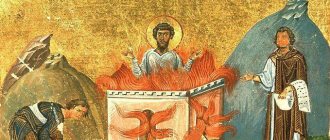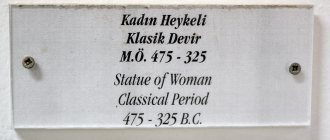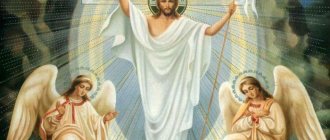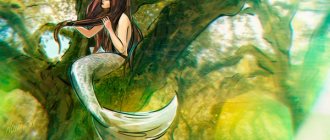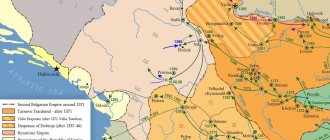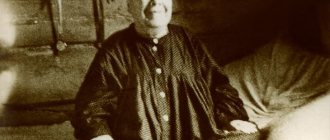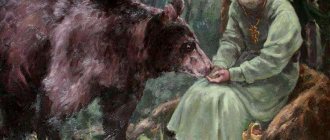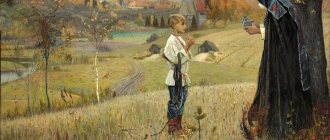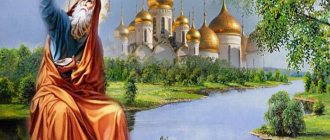"Save me, God!".
Thank you for visiting our website, before you start studying the information, please subscribe to our Orthodox community on Instagram, Lord, Save and Preserve † - https://www.instagram.com/spasi.gospodi/. The community has more than 60,000 subscribers. There are many of us like-minded people and we are growing quickly, we post prayers, sayings of saints, prayer requests, and timely post useful information about holidays and Orthodox events... Subscribe. Guardian Angel to you!
The Orthodox world has a large number of saints. Each of them is approached with different requests. Saint Theodore Stratelates deserves special attention. He is very famous in Orthodoxy. On Memorial Day, February 21, many pilgrims gather at his face to ask for the most secret and desired things.
Prayer to Theodore Stratilates for victory over enemies and the granting of a peaceful sky
“O holy, glorious and all-praised Great Martyr Theodore Stratelates! We pray to you in front of your holy icon: pray with us and for us, servant of God (names), begging God from His mercy, may He mercifully hear us asking for His blessings, may all our requests be fulfilled for salvation and life. We also pray to you, holy victorious Theodore Stratilates, destroy the forces of the enemies, visible and invisible, rising against us. Pray to the Lord God, the Creator of all creation, to deliver us from eternal torment, so that we may always glorify the Father and the Son and the Holy Spirit and confess your intercession, now and ever and unto ages of ages. Amen."
What do they ask the saint for?
Saint Theodore was a warrior. Therefore, all military personnel fall under his special protection.
Before going to the service, the clergy recommend purchasing a small icon with the face of Stratelates, which will protect against dangers.
Prayers addressed to the great martyr have great power and help:
- to be healed from illnesses;
- find a way out of a difficult situation;
- strengthen faith;
- drive out evil spirits.
Theodore Stratelates also helps repentant prisoners, facilitating their early release. Sincere prayers never go unnoticed by the saint.
Prayer to Theodore Stratilates from all evil
“Oh, glorious and highly praised great martyr Saint Theodore, great Stratilates! Do not reject these small prayers and offerings to sinners, but as if you have boldness towards the All-Merciful Master, reach out to us unworthy with your quick help and appear as a warm intercessor for us with Christ God, so that we may not all perish in our sins, but may He deal with us in great mercy His own, may he pacify the world and save us from every evil situation, may he give us a quiet and serene life to live in purity and piety, and at the end of our souls, without condemnation, may we appear before His judgment seat and be worthy to stand at the right hand, may we sing and glorify His All-Holy Name with the Father and the Holy Spirit forever and ever. Amen."
Folk signs on June 21, on Fyodor the Well
On Fedorov's Day there are many signs by which peasants determined the future weather and harvest.
- The real summer days begin on Fyodor Stratelates.
- Heavy dew on Fedor the well - although the summer will be dry, it will produce a good harvest.
- If a thunderstorm hits Stratelates, a lot of bread will be reaped by fire.
- Thunderstorm on Fedorov Day, June 21 - poor hay harvesting.
- Stratilate dew is prophetic - abundant foreshadows good flax and large hemp.
- From Fedorov's day, the dung beetle began to transport the manure to the steam wedge (arable land).
- Thunder in the morning is not good: the man will not clean up the hay (cleaning up the hay will be bad).
- If hail falls on Fedor, there will be cold and a rich harvest.
- The rays of the sun are darkening - expect a strong thunderstorm.
- Summer Fedor - it's time for thunderstorms.
- Heavy dew heralds a harvest.
- Heavy dew means a clear day.
- Birds stop singing three hours before a thunderstorm.
- Dull thunder is for quiet rain, loud thunder is for heavy rain.
- Rooks croak hoarsely - before a thunderstorm.
- If you hear thunder during a thunderstorm, expect prolonged bad weather.
- If the thunder rumbles for a long time, bad weather will last for a long time, and if the thunderclaps seem to move from place to place, then there will be hail and cold weather will set in.
- If at sunset the clouds thicken and become a dark lead color, expect a thunderstorm at night.
- If the dew has not dried before noon, then there will be no rain that day.
- The rain will kill the bread, and the sun will raise it.
- Before a thunderstorm, the forest seems to calm down.
- Thunder is heard in the morning - by the evening it will bring rain, especially if it thunders continuously.
Troparion
Troparion, tone 4
“You were the good commander of the Heavenly King, Theodore, with the true warriorship, the passion-bearing one, you fought wisely with the weapons of faith, and you defeated the demons of the regiment, and you appeared victorious as a sufferer. In the same way, we will always please you with faith.”
Kontakion, voice 2
“With the courage of your soul in faith, you embraced the word of God, like a spear, in your hand, you defeated the enemy, great martyrs Theodora, praying with them to Christ God do not stop for all of us.”
Greatness
“We magnify you, passion-bearing Saint Theodore, and honor your honest suffering, which you endured for Christ.”
National holiday June 21 - Fedorov Day, Fedor Kolodeznik
On June 21, on the eve of the summer solstice, our ancestors celebrated Fedorov's Day. On this day, not only all men with the name Fedor were congratulated, but also the craftsmen who dug wells, respected people in the village, were honored.
According to folk traditions, it was on June 21 that the location for the future well was chosen. In the evening on Fyodor the Well-Maker, the master went around to the places he had chosen in advance and placed a specially enchanted frying pan on the ground there upside down. And in the morning, before sunrise, he lifted them and looked to see if water streams were running along them.
- The dry frying pan indicated that there was no point in digging a well in this place; there was no “water vein” underground.
- If it’s slightly foggy, you can dig it, but such a well will be of little use.
- Well, if the whole frying pan was wet, then there would be a wonderful well with clean water here.
- If it rained at night and the whole pan was wet, then this summer it was better not to dig wells at all - there would be little water in them, and mud would quickly appear in what was there.
If the owner himself decided to dig a well, then he left the house seven times at dawn and noted the places where the first fog lay, after which he got to work.
Akathist to the Holy Great Martyr Theodore Stratelates
Kontakion 1
To the chosen commander and the glorious warrior who suffered, the holy great martyr Theodore, come and sing a song of praise together. But you, great martyr, who have boldness towards the Lord, free us from all troubles, so we call to you:
Rejoice, Holy Great Martyr Theodore, Great Stratilates.
Ikos 1
The Creator of angels and all creation, the Creator, manifests you to His Church, as a valiant sufferer and an invincible warrior, so that everyone, according to the merits of your suffering, will praise you, the passion-bearing Theodora. For this reason, we, like a martyr today, honor you more, blatantly praising you:
Rejoice, you who expose the charm of idolatry’s service.
Rejoice, you who despise the wrath of the mad pagan king.
Rejoice, for this sake you endured great torment and mortal wounds.
Rejoice, for Christ from Pilate, from King Licinius, was nailed in his flesh to the cross.
Rejoice, having wonderfully received life and strength from the Angel of the Lord.
Rejoice, with joy in the Lord bowing your honorable head under the sword.
Rejoice, Holy Great Martyr Theodore, Great Stratilates.
Kontakion 2
Seeing the valiant sufferer and invincible warrior of the holy great martyr Theodore, having received victorious crowns through his suffering and united with angels and giving miracles to the world, we honor the faith of the only wise, chanting to God: Alleluia.
Ikos 2
Having acquired the divine mind, the great and terrible serpent, nesting near the city of Euchaitis, you struck with the cross and sword, the warrior of Christ, and also the stratilate, you were the governor, who was installed on the earth. We, like the heavenly commander, cry out to you:
Rejoice, having freed your fatherland from that cruel serpent by the power of Christ.
Rejoice, you have converted many people to Christ.
Rejoice, conquering the army of demons with the weapon of faith.
Rejoice, for you have come victoriously to the earth as a sufferer.
Rejoice, grant many miracles to those who come running to you with faith.
Rejoice, Christ God pray for us mercifully and do not become impoverished.
Rejoice, Holy Great Martyr Theodore, Great Stratilates.
Kontakion 3
By the power of God, the serpent was killed by Theodore Stratelates, who saw the Euchaitic city and all the surrounding people, marveling and crying out: “Great is the God of Theodore, this is the true God,” - to Him we cry: Alleluia.
Ikos 3
Having the good custom of praying unceasingly at night, Saint Theodore, you were granted a vision of the divine: the cover of the temple, as if it were opened, and the heavenly light, like a great fire, shone upon you; You also heard a voice from above saying: “Be of good cheer, Theodore is with you.” By this you knew that the time of your suffering for Christ had come, and you rejoiced in spirit. We also cry out to you:
Rejoice, for you have seen the unspeakable glory of Christ God.
Rejoice, for you were also a spectator of worldly visions.
Rejoice, for you also had interlocutors on the heavenly earth.
Rejoice, for you were honored with great Mysteries of revelations in earthly life.
Rejoice, prophetic enlightenment.
Rejoice, mental lamp, illuminated by the light of Christ.
Rejoice, Holy Great Martyr Theodore, Great Stratilates.
Kontakion 4
Realizing the storm of torment that was approaching, you prayed with tears, blessed Theodora, Christ God: “Lord, God, all-powerful, be merciful to me and keep me from the deceit of the enemy, so that my enemies will not rejoice.” Likewise, you and I cry out to God: Alleluia.
Ikos 4
Hearing the evil king’s seductive words, like offering sacrifices and censers and aromas to the vile gods, the blessed Theodora, I crushed him in one night and, crushing all the gold and silver idols into small pieces, I divided them among the orphans and the wretched. For this reason, greatly marveling at your undaunted feat, we cry out to you:
Rejoice, having put to shame the most shameless king by the wisdom of your words.
Rejoice, you who preached the glory of God alive and true before tongues.
Rejoice, for truly Theodore, who is the gift of God, has appeared.
Rejoice, for now the angels and the faces of the martyrs rejoice more blessedly.
Rejoice, for you have boldness towards God and deliver us all from sorrows and passions.
Rejoice, Holy Great Martyr Theodore, Great Stratilates.
Life of a Saint
The saint was from the city of Evkhait, which is located on the Black Sea coast. A large number of pagans who saw kindness and good deeds began to accept the faith of Christ. When the emperor found out about what was happening, he personally came to Fedor with a request to begin bowing to idols and renounce faith in Jesus.
But the saint did not remain steadfast, so he was subjected to severe torture and cruelty. The end result was that he was nailed to the cross. The night after this, an angel appeared to him and took his body down from the cross and revived him. The next morning the emperor's servants saw Fedor alive and well. After what happened, many people believed in Christ and abandoned idol worship. Having learned about this, the emperor ordered the execution of Stratelates.
He died in 319. All his suffering was seen by his servant, who described all the stories.
The best article for you, go to: St. Nikita the recluse of Pechersk, Bishop of Novgorod
The position of Christians in the Roman Empire at the end of the 3rd century. n. e.
According to the tradition of the Orthodox Church, Theodore Stratelates was born in Asia Minor in the city of Euchait. He was a brave, handsome young man who professed Christianity. At a fairly young age, he enlisted in the Roman army. During the reign of Emperor Licinius, severe persecution of Christians began. However, the Romans saw that those who believed in the Savior joyfully accepted martyrdom for their faith. Then the pagans began to persecute Christians who held government positions and were respected by the people. For this purpose, the Forty Martyrs of Sebastia and several other important dignitaries from Licinius’ entourage were killed.
Deceived cunning
But suffering awaited the Great Martyr Theodore Stratilates ahead. Emperor Licinius (bust in the photo below) was a pagan and became the murderer of a saint. Punishment for all his crimes overtook him in 324 AD. e., when Emperor Constantine the Great, the forerunner of the Christian era of the Roman Empire, finally defeated the pagan Licinius, becoming the rightful ruler of the empire. And he ordered the former co-ruler to be exiled and later executed.
But then, in 319 AD. e., Licinius fought against the Church. For more than two hundred years, Christians have been dying for their faith, but faith did not die with them; more and more pagans were turning to Christ. Licinius realized long ago that apostasy from the faith is preferable to death for it. In addition to the traditionally severe persecution of Christians, he decided to act cunningly and politically prudently - to convert noble and famous Christians to paganism. He also wrote a letter to Theodore Stratelates. Having received and dismissed the emperor's envoys with great honors, Theodore invited the emperor to come and visit him with silver and gold idols, since he himself could not leave the service and leave Heraclea. Explaining this by saying that the people are rebellious, subject to any harmful influence of Christian teaching, but if they only see how the emperor himself and his faithful stratilate worship the pagan gods together, then ordinary people will be inspired and follow their example.
Licinius fell into a trap, he himself collected and brought all the pagan idols to Theodore’s house, expecting that the next day they would give them all the appropriate honors and sacrifices together in front of the whole people. That same night, Theodore Stratelates smashed all the statues and distributed the fragments to the poor.
Fedorovsky Monastery in Pereslavl-Zalessky
In 1304, Muscovites and Tver residents came together in a battle for power. In honor of the victory, the Moscow prince ordered the foundation of the Fedorov Monastery at the site of the terrible battle. The first and oldest building of the monastery complex is Fedorovsky Cathedral, dating back to 1557. Ivan the Terrible himself donated money for construction on the occasion of the birth of his son Fyodor. With the donations of Princess Natalya Alekseevna, the sister of Peter the Great, whom he loved very much, two more churches of the monastery were built - the hospital Church of the Kazan Icon of the Mother of God and the refectory Church of the Presentation.
In 1667, a pestilence decimated the population of Pereslavl-Zalessky, leaving behind many widows and girls who wandered or huddled with local residents. They should become nuns, but where? A monastery for men, even if there are only ten monks. Tsar Alexei Mikhailovich and Patriarch Joseph took pity on the poor women - they turned the monastery into a women's monastery, transferred the monks to surrounding monasteries, and donated land to the monastery to feed the novices. Also, a variety of crafts have always flourished in the monastery - from weaving to an icon-painting workshop.
Kostroma
The family of the Romanov Tsars has a patron icon - the Fedorov Icon of the Mother of God. It is believed to have been written by Luke, one of the four evangelists. The name of the icon was given by the father of Alexander Nevsky, who at baptism was named Fedor in honor of Theodore Stratilates.
The icon has a colorful history with many signs. And its acquisition is associated with Theodore Stratilates, the patron saint of Kostroma, the city where the icon is now kept. It was Theodore that the people of Kostroma saw the day before the fateful hunt, when the prince and the younger brother of Alexander Nevsky, Vasily Kostroma, chasing the beast, found the icon in the forest on a tree. A certain warrior, similar to the image of Stratilates in the Kostroma Cathedral, had walked the streets of the city the day before, holding an icon in his hands. Until that day, it was considered to have burned down along with the Gorodets Chapel, in which it was previously kept.
Foreign princesses-brides of princes took the patronymic name Feodorovna when they converted to Orthodoxy, also in honor of this icon-patron of the family.
The end of the Time of Troubles at the end of the 15th and beginning of the 16th centuries and the election of Mikhail Fedorovich to the kingdom, the beginning of the reign of the Romanov family, are also associated with it. When on March 23, 1613, the ambassadors of the Zemsky Sobor arrived to inform him of the election, the mother of the future king, nun Martha, for a long time did not agree to bless her son to reign. And only when she prostrated herself before the Feodorovskaya icon, through a prayer to the Mother of God, from whom she asked for wisdom for the future ruler and grace for the whole country, she agreed.
The Great Martyr Theodore Stratelates preached both through life and through martyrdom about his Great God, and after his death he did not abandon his ministry!
Preaching
After saving Euchaites from the monster, Theodore was appointed stratilate (military leader) to the city of Heraclea. There he began to openly preach Christianity and succeeded in this matter. Soon Emperor Licinius was informed that most of the inhabitants of Heraclea and its environs had been converted to the new faith. He sent dignitaries to the stratilate who were supposed to bring Theodore to Rome. However, the future great martyr himself invited the emperor to Heraclea. He promised him to arrange a demonstrative sacrifice to the pagan gods in order to prove his devotion to Rome and the emperor, and also to serve as an example for the people.
After the letter was sent, Fyodor began to pray day and night, until one day he was illuminated by an unearthly light and heard a voice from heaven that said: “Be of good cheer! I'm with you!
Theodore Tyrone
There are many icons that depict two warriors in armor. This is Feodor Stratelates and his namesake, nicknamed Tyrone. According to legend, both warriors were born in the same Roman province. Theodore Tiron was a warrior of the Marmarite regiment stationed in the city of Amasia. He refused to obey his centurion Vrink and did not take part in public idol worship. For this he was brutally tortured and then burned at the stake. However, the remains of the great martyr were not damaged by fire, and they were buried in her house by the Christian Eusevia.
The lives of both saints are closely intertwined with each other, and they are often depicted together. This is due to the fact that during the existence of the Byzantine Empire, these great martyrs personified the Christian principle in the military power of the state. Both Theodores were also associated with St. George the Victorious, probably from a similar story with the victory over the serpent.
Veneration and relics
In Rus', Saint Theodore Stratilates has been revered since ancient times as the patron saint of the army. In ancient icon paintings there are characteristic features by which one can immediately identify the saint:
- the saint is dressed in plate armor;
- in the right hand there is a spear;
- Slavic shield, oval;
- The horse's color is white.
Sometimes, instead of a spear, the saint holds a sword in his hands, and a cross in the other hand. That is, the images of Stratelates are very diverse in the ancient tradition, which has passed on to our time, and the icons of Stratelates can most often be seen in precisely this setting.
More about icons of saints:
- Icon of Saint Stylian of Paphlagonia
- Icon of Saint Artemy Verkolsky
- Icon of St. Demetrius of Thessalonica
Icon of Saint Theodore Stratilates
After his martyrdom, the holy relics of Theodore Stratilates were transferred to the main temple of the city of Euchaitis. In the 11th century they ended up in Constantinople. Each time during the transfer, many miracles occurred through prayers to the saint. The relics were placed in the Church of the Virgin Mary in Blachernae. Next to them were Theodore's shield and sword.
The further fate of St. of the relics of Theodore Stratilates was tragic. After the capture of Constantinople by the Crusaders in 1204, they were not preserved intact and parts of them ended up in various Orthodox and Catholic churches:
- chapter on Mount Athos in the Pantokrator monastery;
- left hand in the Greek Peloponnese at the Mega Spileon monastery.
In Russia, particles of relics are found in the following churches:
- in the Annunciation Cathedral in Moscow;
- in the Church of St. Sophia in Novgorod the Great;
- part of the head of the saint under Boris Godunov were also brought to Moscow.
Ark with a particle of relics in the Feodorovsky convent
After his martyrdom, Theodore Stratelates was glorified by the Church as a Great Martyr. And through prayers to him there were many miracles.
- One of the very first occurred in 780. In the church of St. Theodore in the Syrian city of Karsat, the Saracens were stationed, one of them shot with a bow at the fresco of the saint on the wall and hit him in the shoulder, from which blood began to flow. After this, all the Saracens who were in the temple died for an unknown reason.
- In 971, in the battle with the Russians, Saint Theodore, at the decisive moment, when the forces of the Romans weakened, Stratilates appeared ahead of the army and the Russians fled in panic.
These are the most famous cases, but there were many others, and they are now performed through prayers to St. Vmch. Theodore Stratilates.
Chelter-Koba
The monastery of Theodore Stratelates, which is considered one of the oldest on the peninsula, still operates in Crimea to this day. It was founded by icon worshipers in the 8th-9th century, and existed until 1475, when the Principality of Theodoro was captured by the Ottoman Empire. 15-20 people lived in the monastery. In total, 22 caves for various purposes have been preserved, including those used as cells. There is also a large refectory hall.
The revival of the monastery, which belongs to the Russian Orthodox Church, began in 2000.
Now you know the details of the life of one of the most famous great martyrs, revered by the Orthodox and Catholic churches. You also know where the famous Temple of Theodore Stratelates is located in Veliky Novgorod, so when you are in this city, you will be able to admire this magnificent work of medieval Russian architecture.
First feat
The warrior was handsome and endowed with many talents. But he chose prayer as his main weapon. Theodore Stratelates became aware of a monstrous snake that was devouring cattle and people in the vicinity of Euchaitis, his hometown.
The serpent is a frequently used image of the eternal enemy of Christ - Satan, the ancient serpent-tempter, the dragon. Many holy people were dragon slayers. Stratilates' compatriot and namesake, Theodore Tyrone, saved his mother Eusevia from the dragon. It was she who later helped Stratelates defeat the serpent from Euchait.
Theodore Stratelates, without taking anyone with him, but only after praying, went alone to search for the enemy. In the field next to the serpent's lair, he let his horse graze, and he fell asleep. Not far from that place lived Tyrone’s mother, the Christian Eusevia, who woke up the warrior and begged him to leave. But he, calling on God for help, asked Eusebia to pray, and he bravely rushed at the enemy. Theodore Stratelates struck with his sword, and the horse, at the request of the rider, trampled the snake with its hooves - and God granted victory. The pagan locals praised the “Great God Theodore,” and many of them were baptized.
In the photo above there is a stamp from the Novgorod icon “Theodore Stratilates with the Life” about this feat.
In recognition of the valor of Theodore Stratelates, the emperor of the Eastern part of the Roman Empire, Licinius, appointed him stratelate of the city of Heraclea. Now this is the Black Sea coast of Turkey. He served regularly, by example and word, converting the pagans subordinate to him from idolatry to Christ.
Velikiy Novgorod
In this ancient city there are two churches of Theodore Stratelates. One is located on the street. Shchirkov, on the Sofia side. Who founded and built it and when is unknown, but it stood even before the Mongol yoke. Then it was dedicated to Theodore Tyrone, with whom Stratilates is often confused. And there are many reasons for this.
The saints lived practically at the same time and in the same area; both were warriors and dragon slayers. Eusevia, Tyrone's mother, who buried the body of Theodore Tyrone near her house after his martyrdom, commemorated her son every year. She also helped Theodore Stratilates in the battle with the serpent not far from her home. The martyr Stratilates was buried there, next to Theodore Tyrone.
The Church of Theodore Stratelates (formerly Tyrone) was rebuilt several times. In 1804, a bell tower was added to it, and since then the architecture has remained unchanged. During the Great Patriotic War, the city was almost completely destroyed, but this church was almost undamaged.
Another church of Theodore Stratilates stands not far from Fedorovsky Stream and is called the Church on the Stream (pictured above). This is one of the most famous holy places in Russia associated with the name of the great martyr. Even for Novgorod, which has many ancient holy places and relics, this church is very remarkable. It was built in the classical Novgorod style in the 14th century, but with many decorative elements on the facades, which is a significant departure from the architectural rigor of other churches of that era. There are suggestions that the author of the frescoes that decorate the temple from the inside and are partially preserved is the famous Theophanes the Greek. They are made in an unusual red-brown color scheme for Novgorod. Although the Slavic type of appearance of the saints on the frescoes indicates that the authors were Novgorod artists - students of Theophanes the Greek.
